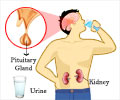
‘Copeptin, a fragment of the antidiuretic hormone (ADH) or arginine vasopressin prohormone can help distinguish diabetes insipidus from primary polydipsia which is characterized by excessive fluid intake. Copeptin testing is more stable and easier to measure.’
Tweet it Now
Two diagnostic approaches are the water-deprivation test (with serial measurements of urine and plasma osmolality) and the response to administration of hypertonic saline, but both approaches have limitations. Direct measurement of the response of plasma antidiuretic hormone (ADH, or arginine vasopressin) to provocative testing is potentially helpful, but assays for ADH can be unreliable. Copeptin, a fragment that is cleaved from the ADH prohormone, is more stable and easier to measure.
In this study, researchers studied 141 patients with hypotonic polyuria; ultimately, 58 percent received diagnoses of primary polydipsia, and 42 percent received diagnoses of partial or complete central diabetes insipidus. All patients underwent both water-deprivation and hypertonic-saline testing; plasma copeptin was measured during testing.
A hypertonic saline–stimulated plasma copeptin level lower than 6.5 pmol/L was 95 percent sensitive and 100 percent specific for central diabetes insipidus. This test's accuracy was superior to that of water-deprivation testing (with or without measurement of copeptin), and it distinguished between primary polydipsia and both partial and complete central diabetes insipidus.
Source-Medindia















